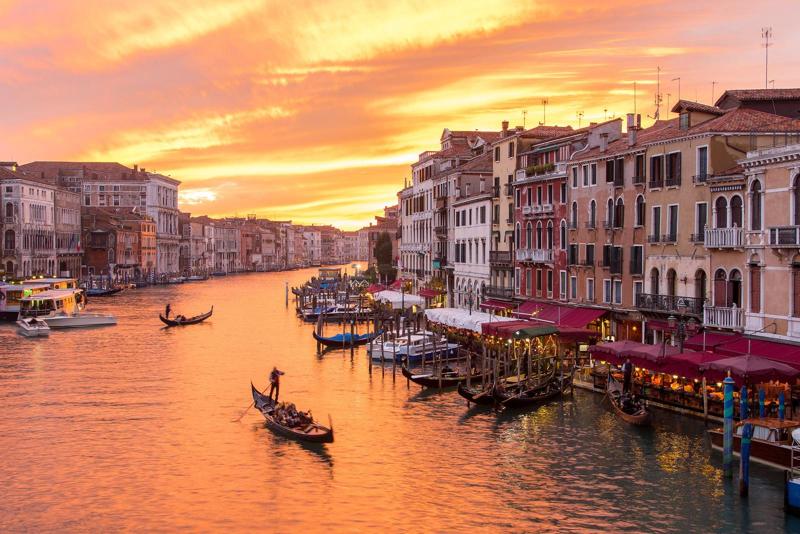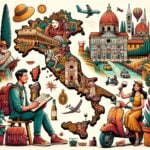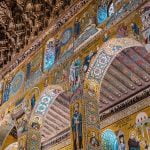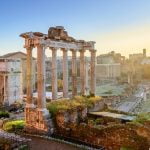Italy, with its rich history and vibrant culture, is undeniably one of the most attractive destinations for travelers. From breathtaking architecture to world-renowned art masterpieces and delicious cuisine, this country has it all.
However, to truly appreciate and understand the wonders of Italy, it is crucial for travelers to delve into its fascinating history. By exploring the historical influences that shaped Italy’s past and present, visitors can gain a deeper appreciation for the sights they encounter and the experiences they have during their journey.
Understanding the history of Italy provides a context for appreciating its architectural marvels, such as the Colosseum and the Leaning Tower of Pisa. It unveils the origins of a civilization that laid the groundwork for Western culture and influenced countless generations through its innovations in art, philosophy, and governance.
Additionally, knowledge of Italy’s history allows travelers to comprehend the complexities of its city-states during the Renaissance era, from Florence to Venice, which fostered monumental advancements in art and literature.
Moreover, comprehending Italy’s past sheds light on significant periods like unification struggles that shaped the modern nation we see today. Exploring both positive achievements and dark chapters like the Fascist Era gives travelers a more holistic understanding of Italy’s journey towards progress. It also offers insights into post-war reconstruction efforts that transformed Italy into a modern nation while preserving its rich traditions and cultural diversity.
By grasping Italy’s historical narrative before setting foot on Italian soil, travelers can immerse themselves in a profound experience that goes beyond mere sightseeing. Whether indulging in Italian cuisine or observing customs during local festivals or interactions with locals, an understanding of Italian history allows for a deeper connection with Italian culture. It helps travelers appreciate how traditions have evolved over time while remaining integral parts of daily life.
Throughout this article series, we will explore different facets of Italian history that are indispensable for any traveler. From tracing historical influences in art masterpieces to discovering the culinary heritage passed down from generations, we will delve into how history has shaped Italy’s culture, customs, and artistic achievements.
Additionally, we will offer tips and suggestions for maximizing your travel experience while exploring historical sites in Italy. So fasten your seatbelts and get ready for an unforgettable journey through Italy’s captivating past.
Ancient Italy
The section on Ancient Italy provides a glimpse into the origins of the Italian civilization, shedding light on the roots of the culture and traditions that still prevail today. Ancient Italy refers to the pre-Roman period when various tribes and civilizations thrived on the Italian Peninsula.
One of the most prominent ancient civilizations in Italy was the Etruscans, who inhabited an area called Etruria in central Italy from around 900 BCE to 100 BCE. The Etruscans were known for their advanced city planning, sophisticated art, and skilled craftsmanship. They also played a crucial role in transmitting Greek culture to Rome.
Another significant civilization in ancient Italy was the Greeks, who established colonies along the southern coast of Italy, particularly in regions like Magna Graecia (Greater Greece). These colonies became important centers of trade and cultural exchange between Greek and native Italic cultures.
Moreover, it is essential to mention the impact of ancient Rome during this period. Although Rome rose to prominence later on, its roots can be traced back to ancient times when it was a small city-state surrounded by other more powerful civilizations on the Italian Peninsula.
Understanding Ancient Italy is vital for travelers as it allows them to appreciate the historical context behind famous landmarks such as the Colosseum, Pompeii, and countless archaeological sites scattered across the country. By delving into this era of history, visitors can gain a deeper understanding of how Italy’s rich cultural heritage has evolved over time.
| Ancient Italian Civilization | Key Features/Contributions |
|---|---|
| Etruscans | – Advanced city planning
|
| Greeks | – Greek colonies in southern Italy
|
| Roman Empire | – Rise of Rome as a city-state
|
The Roman Empire
Italy’s role in history cannot be discussed without delving into the grandeur and influence of the Roman Empire. From its humble beginnings as a small settlement on the banks of the Tiber River, Rome grew to become one of the most powerful and influential civilizations in history. The rise and fall of the Roman Empire shaped not only Italy but also had a profound impact on Western civilization as a whole.
The Rise of Rome
It all began in 753 BC when Romulus, according to legend, founded the city of Rome. Over time, Rome expanded its territories through military conquests and strategic alliances. By 146 BC, after defeating Carthage in the Punic Wars, Rome emerged as the dominant power in the Mediterranean region. This marked the beginning of centuries-long dominance that laid the foundation for Italy’s future.
The Pax Romana
One key aspect that distinguishes Rome’s rule was the concept of Pax Romana or “Roman Peace.” During this period, from 27 BC to 180 AD, Italy experienced relative stability and prosperity under Roman rule. This allowed for advancements in infrastructure, trade networks, law, literature, and architecture. Cities such as Rome, Pompeii, and Ostia flourished during this time, leaving behind an impressive architectural legacy that can still be admired today.
Cultural Contributions
The Romans were not only renowned for their military prowess but also for their contributions to art, literature, philosophy, and governance. They assimilated elements from various cultures they encountered throughout their vast empire and blended them with their own traditions to create a unique cultural identity. Roman art was characterized by its realistic sculptures and vibrant frescoes while literary works like Virgil’s epic poem “The Aeneid” showcased their storytelling skills.
Italy’s rich artistic heritage can be traced back to this period, with famous landmarks such as the Colosseum, the Pantheon, and the Baths of Caracalla being prime examples of Roman architecture. The influence of Roman culture can also be seen in modern-day infrastructure and governance systems. By understanding the legacy of the Roman Empire, travelers can gain a deeper appreciation for Italy’s historical and cultural significance while exploring its magnificent ruins and ancient sites.
As we continue our journey through Italy’s history, the next section will focus on Medieval Italy: The birth of city-states and the Renaissance.
Medieval Italy
During the medieval period, Italy saw the birth of city-states and witnessed a cultural and intellectual revolution known as the Renaissance. This era was a significant turning point in Italian history and had a profound impact on European civilization as a whole.
The city-states of medieval Italy emerged as independent political entities that were governed by wealthy merchant families. These city-states, such as Florence, Venice, and Milan, became centers of trade, commerce, and intellectual exchange. Each city-state had its own unique characteristics and rivalries, creating a rich tapestry of political dynamics within Italy.
One of the most important developments during this time was the rise of the Renaissance. Characterized by a renewed interest in classical learning and art, the Renaissance in Italy sparked unprecedented advancements in various fields such as literature, architecture, painting, sculpture, and science. Artists like Leonardo da Vinci, Michelangelo Buonarroti, and Raphael Sanzio produced masterpieces that are still revered today.
Furthermore, the invention of the printing press allowed for the rapid dissemination of knowledge throughout Europe. Italian scholars preserved ancient Greek and Roman texts by translating them into Latin or vernacular languages such as Italian. This revival of classical knowledge played a crucial role in shaping intellectual thought not only in Italy but also across Europe.
Visitors to Italy today can explore numerous historical sites that reflect this medieval period’s significance. In Florence, one can marvel at architectural wonders like Brunelleschi’s dome on top of Santa Maria del Fiore Cathedral or visit museums housing priceless works from Renaissance masters. In Venice, visitors can navigate through its intricate canal system while experiencing exquisite Byzantine-influenced architecture.
To fully immerse oneself in the history and culture of medieval Italy during their travels, here are some tips:
- Take guided tours: By joining guided tours led by knowledgeable experts, travelers can gain deeper insights into historical sites’ significance and make the most of their visit.
- Visit museums and art galleries: Italy is home to some of the world’s most renowned museums and art galleries, showcasing masterpieces from the Renaissance period. Exploring these institutions allows travelers to appreciate the artistic and intellectual achievements of medieval Italy.
- Attend festivals and cultural events: Many cities in Italy host festivals that celebrate their medieval heritage. These events provide a unique opportunity to witness historical reenactments, traditional performances, and immerse oneself in the vibrant atmosphere of medieval Italy.
By understanding the significance of medieval Italy, travelers can truly appreciate the country’s rich history, artistic achievements, and cultural traditions. Whether exploring ancient ruins, admiring breathtaking artworks, or participating in local festivities, delving into this captivating era will undoubtedly enhance any traveler’s experience in Italy.
Unification of Italy
The Unification of Italy was a significant and complex process that spanned several decades, culminating in the creation of a unified Italian nation. This section will delve into the key events and figures that contributed to this quest for unity.
One of the most prominent figures in the unification movement was Giuseppe Garibaldi. Garibaldi was an Italian general and nationalist who played a crucial role in liberating various regions of Italy from foreign control. He became known for his military expertise and charismatic leadership, leading volunteer forces known as the “Redshirts” in successful campaigns across Italy.
Another key figure in the unification movement was Count Camillo di Cavour. Cavour was an influential statesman who served as the Prime Minister of Piedmont-Sardinia, which was one of the main driving forces behind Italian unification. Cavour’s political maneuvering and diplomatic skills were instrumental in gaining international support for the cause of Italian unity, particularly from nations like France.
The pivotal moment in the unification process came in 1861 when Victor Emmanuel II, King of Piedmont-Sardinia, assumed the title of King of Italy. With this proclamation, Italy officially became a united nation under one monarch. However, it is important to note that this initial unification did not include all regions with Italian populations, such as Rome and Venice, which were still under foreign control.
Overall, the unification of Italy represents a remarkable chapter in Italian history, marked by passionate nationalism and persistent efforts to create one cohesive nation. This period laid the foundation for modern-day Italy and continues to shape its political and cultural identity today.
| Key Figures | Main Contributions |
|---|---|
| Giuseppe Garibaldi | Liberation campaigns; leadership of “Redshirts” |
| Count Camillo di Cavour | Political maneuvering; international support for unification |
| Victor Emmanuel II | Became King of Italy; official proclamation of Italian unification |
Fascist Era
The Fascist Era in Italy is widely regarded as a dark chapter in the country’s history. This period, from 1922 to 1943, saw the rise of Benito Mussolini and his National Fascist Party, which sought to establish a totalitarian regime in Italy. Understanding this era is crucial for travelers visiting Italy, as it allows them to gain insight into the country’s past and its impact on modern-day Italy.
During the Fascist Era, Italy experienced a significant shift in its political landscape. Mussolini aimed to revive the glory of ancient Rome by promoting fascist ideology and establishing autocratic rule. He implemented a number of policies that controlled almost every aspect of people’s lives, including suppressing political opposition, censoring the media, and creating a cult of personality around himself.
The Fascist Era also witnessed Italy’s alliance with Nazi Germany during World War II. Mussolini believed that aligning with Hitler would bring strength and prestige to Italy. However, this alliance resulted in devastating consequences for the country. The war brought destruction, loss of life, and economic ruin to Italy.
Travelers can explore various aspects of this dark chapter in Italian history through museums and historical landmarks across the country. For example, Palazzo Venezia in Rome was Mussolini’s headquarters during his time in power and now serves as a museum dedicated to fascism. Visitors can learn about Mussolini’s rise to power and witness propaganda materials from that era.
By delving into this period of Italian history, travelers can gain a deeper understanding of how it has shaped modern-day Italy. It serves as a reminder of the importance of democratic values and encourages reflection on past mistakes. Overall, knowledge about the Fascist Era provides valuable context for travelers exploring Italy’s rich cultural heritage.
Post-War Italy
After the devastation of World War II, Italy faced the monumental task of rebuilding and transforming itself into a modern nation. This period marked a significant turning point in Italian history, as the country worked towards recovering from the ruins of war and reshaping its identity. Understanding this post-war era is crucial for travelers who want to fully appreciate Italy’s journey towards becoming the vibrant and culturally rich nation it is today.
The Economic Miracle
One of the most remarkable aspects of post-war Italy was its economic recovery, known as the “Italian Economic Miracle”. From the late 1940s to the 1960s, Italy experienced rapid industrialization and unprecedented economic growth. The country’s focus shifted towards rebuilding infrastructure, expanding industries, and creating job opportunities. As a result, there was a significant improvement in living standards and a rise in urbanization.
Social Changes and Political Shifts
The post-war period also brought about profound social changes and political shifts in Italy. The end of World War II saw the fall of fascism and the establishment of a democratic republic. A new constitution was adopted in 1947, providing Italian citizens with fundamental rights and freedoms. Moreover, society began to experience transformative changes as women gained more rights, traditional family structures evolved, and cultural norms shifted.
Cultural Renaissance
During this time of rebuilding, Italy also experienced a cultural renaissance that had lasting effects on art, literature, cinema, and design. Influenced by influences such as neorealism and existentialism movements both domestically and internationally (Check if content can be verified later), Italian artists embraced new forms of expression that reflected their experiences during wartime. This era produced renowned filmmakers like Federico Fellini and Michelangelo Antonioni while giving birth to iconic pieces from prominent artists like Lucio Fontana.
Overall,pthe post-war period was a pivotal time for Italy as it embarked on a journey of transformation and reconstruction. Understanding this part of the country’s history allows travelers to fully grasp the resilience and determination of the Italian people. Furthermore, it provides insight into the cultural and social changes that took place during this time, shaping Italy into the modern nation that attracts travelers from every corner of the globe.
Contemporary Italy
Italy is not only a country with a fascinating past, but it also boasts a vibrant and diverse contemporary culture. Today, Italy is known for its rich traditions, varied regional customs, and thriving arts scene. Understanding the contemporary aspects of Italian society is crucial for travelers who want to fully immerse themselves in the country’s unique atmosphere.
One of the defining features of contemporary Italy is its regional diversity. Italy is divided into 20 regions, each with its own distinct culture, dialects, and culinary traditions. From the bustling fashion capital Milan to the charming canals of Venice and the historic city of Rome, each region offers a different experience.
Travelers can explore the trendy art galleries in Florence or enjoy the laid-back lifestyle on the Amalfi Coast. By embracing the regional differences, visitors have the opportunity to discover firsthand what makes each part of Italy special.
Another aspect that sets contemporary Italy apart is its deep-rooted traditions. Italians hold their customs close to heart and take great pride in preserving them. From religious festivals such as Easter processions to traditional food festivals like Sagra del Pesce (Fish Festival), these events offer a glimpse into Italy’s cultural heritage. Travelers can participate in local celebrations or witness traditional craftsmanship that has been passed down through generations.
Furthermore, contemporary Italian society thrives on its rich artistic influences from history. Italy has long been renowned for its contribution to art and is home to many world-famous museums and galleries showcasing masterpieces by renowned artists such as Michelangelo and Leonardo da Vinci. Today, modern Italian artists continue to push boundaries in various forms like visual arts, architecture, film, and fashion. Exploring contemporary Italian art scene provides an insight into how historical influences continue to shape artistic expressions.
Italian art and architecture
Italian art and architecture have had a profound impact on the world, with its masterpieces attracting millions of tourists each year. The rich history of Italy has greatly influenced its artistic traditions, resulting in a diverse range of styles and techniques that have left an indelible mark on the world of art. Tracing the historical influences in Italy’s artistic masterpieces provides travelers with a deeper understanding and appreciation for the country’s cultural heritage.
One of the most notable periods in Italian art history is the Renaissance, which emerged in the 14th century. This period saw a renewed focus on humanism and classical Greco-Roman ideals, leading to an explosion of creativity across various artistic disciplines. Inspired by ancient works of art and architectural achievements, artists such as Leonardo da Vinci, Michelangelo, and Raphael revolutionized painting, sculpture, and architecture respectively.
The influence of ancient Roman architecture can be seen in iconic landmarks such as the Colosseum and Pantheon. These grand structures showcased advanced engineering techniques and monumental scale, leaving visitors awestruck by their sheer magnificence. The architectural style of these ancient wonders has been emulated throughout history, inspiring countless buildings worldwide.
Furthermore, Italy is home to renowned art cities such as Florence, where masterpieces like Botticelli’s “The Birth of Venus” can be found at the Uffizi Gallery. Florence also boasts impressive architectural wonders like Brunelleschi’s Dome atop Florence Cathedral. In Venice, visitors can marvel at the intricate mosaics adorning St. Mark’s Basilica or explore stunning Gothic palaces along its canals.
Italian Art & Architecture Influences
| Period | Main Influences |
|---|---|
| Ancient Rome | Greek architecture and engineering techniques |
| Renaissance | Classical Greco-Roman ideals, humanism |
| Baroque | Religious themes, dramatic lighting, extravagant ornamentation |
| Neoclassicism | Inspired by ancient Greece and Rome, symmetrical and balanced compositions |
| Futurism | Embraced technology, modernity, and the dynamism of urban life |
Whether it’s the frescoes of the Sistine Chapel in Rome, the sculptures of Bernini in Vatican City, or the architectural wonders of Florence and Venice, Italy’s art and architecture continue to captivate visitors from around the globe. By tracing the historical influences in Italy’s artistic masterpieces, travelers can gain a deeper appreciation for the country’s cultural heritage and understand how its past has shaped these incredible artistic achievements.
The impact of history on Italian cuisine
Italian cuisine is renowned worldwide for its rich flavors and diverse ingredients. The history of Italy has played an instrumental role in shaping the country’s culinary heritage, with each region having its own unique dishes and specialties. Understanding the impact of history on Italian cuisine is essential for travelers who want to fully immerse themselves in the country’s gastronomic delights.
Ancient Influences
Italy’s culinary tradition can be traced back to ancient times, where different civilizations left their mark on the country’s food culture. The Etruscans, Greeks, and Romans all contributed to the development of early Italian cuisine. The Etruscans introduced olive oil and wine production, while the Greeks brought a variety of herbs and spices that added depth to Italian dishes. The Romans embraced culinary diversity by incorporating ingredients from their vast empire and expanding trade networks.
The Renaissance and Beyond
During the Renaissance, Italy experienced a cultural rebirth that had a significant impact on its cuisine. This period marked an increased focus on art, philosophy, science, and exploration. It also led to a greater interest in food and cooking techniques. The discovery of new ingredients during voyages to new lands influenced Italian cuisine greatly; tomatoes from the Americas became a staple ingredient in many dishes.
In more recent history, factors like political divisions and economic struggles have shaped regional cuisines in Italy. Immigration from various countries has also introduced new flavors and culinary traditions into Italian cuisine. Today, Italy’s culinary landscape represents a rich tapestry woven together by historical influences from different time periods.
Understanding “The impact of history on Italian cuisine: Exploring the culinary heritage of Italy from past to present” allows travelers not only to appreciate the flavors but also to gain insight into local traditions and cultures through food. Exploring local markets, trying traditional recipes passed down through generations, or enjoying a meal at family-run trattorias provide intimate glimpses into Italy’s culinary heritage.
By embracing the influences of history on Italian cuisine, travelers can truly indulge in a gastronomic journey that connects them with Italy’s rich past and vibrant present.
Understanding Italian culture through history
Italy is a country with a rich and vibrant culture, deeply influenced by its historical past. Understanding the history of Italy is therefore crucial for travelers who want to truly immerse themselves in the country’s customs and traditions. Through an exploration of Italy’s varied historical periods, from ancient times to the present day, visitors can gain a deeper appreciation for the unique aspects of Italian culture that continue to thrive today.
Ancient Italy: Uncovering the roots
Ancient Italy holds the key to understanding many of the customs and traditions that still exist in modern-day Italy. From language to cuisine, architecture to religious practices, these cultural elements all trace their origins back to ancient civilizations such as the Etruscans and the Greeks. For example, a visit to Pompeii or Herculaneum reveals insights into daily life in ancient Rome, including Roman dining habits and social norms.
The Renaissance: Celebrating art and humanism
The Renaissance was another critical period that shaped Italian culture. It marked a revival of interest in classical arts and sciences, leading to a burst of creativity that produced some of history’s greatest artistic masterpieces. The movement centered around Florence, birthplace of iconic figures like Leonardo da Vinci and Michelangelo. Travelers exploring this period can witness firsthand how art became intertwined with religion and explore world-famous museums such as the Uffizi Gallery or The Vatican Museums.
The influence of history on language and festivals
Language is another significant aspect through which history has shaped Italian culture. The Italian language itself evolved from Latin but was also influenced by various invaders over centuries – from Lombards to Normans to those who spoke Venetian dialects. Similarly, historical events have left their mark on popular Italian festivals celebrated throughout the year. For example, Carnevale in Venice has its roots in medieval festivities before Lent while celebrating Venice’s unique culture and traditions.
By delving into Italy’s history, travelers can gain a profound understanding of the customs, traditions, and values that define Italian culture. Whether it is witnessing the impact of ancient civilizations on modern-day Italy or exploring the art and humanism of the Renaissance, each step in this historical journey reveals valuable insights about Italy’s past and present. By embracing this knowledge, travelers can create an unforgettable journey through time in this remarkable country.
Tips for exploring historical sites in Italy
Exploring the historical sites in Italy offers an incredible opportunity to immerse yourself in the fascinating history of this ancient civilization. From ancient ruins to magnificent cathedrals, Italy boasts a wealth of historical landmarks that are sure to leave a lasting impression. To make the most of your visit and enhance your travel experience, here are some valuable tips to consider when exploring historical sites in Italy.
Firstly, it is essential to plan your visit ahead of time. Researching about the historical site you plan to visit will not only enrich your understanding but also save you time and effort. Learn about the significance and historical background of each site, as well as any specific rules or regulations that may be in place.
Some sites require advanced ticket reservations or have limited visiting hours, especially during peak tourist seasons. By planning ahead and obtaining necessary tickets or passes beforehand, you can avoid long queues and ensure a smooth and seamless experience.
Secondly, consider opting for guided tours or hiring local guides when visiting historical sites in Italy. A knowledgeable guide can provide valuable insights about the site’s history, architecture, and cultural significance that you might otherwise miss.
They can help bring the past to life by sharing captivating stories and anecdotes that enhance your understanding of the site’s historical context. Moreover, guides often know hidden gems or lesser-known facts about the site that can make your visit even more memorable.
Lastly, take time to appreciate the beauty surrounding you while exploring historical sites in Italy. Many of these sites are located within stunning landscapes or are architectural marvels themselves.
Allow yourself to fully immerse in the atmosphere of each location by taking leisurely walks, capturing breathtaking photos, or simply finding a quiet spot to absorb the ambiance around you. Remember that experiencing history is not just about ticking off attractions from a list but also about connecting with the soul of each place.
By following these tips, you can maximize your travel experience when exploring the historical sites in Italy. Whether it’s marveling at ancient ruins or admiring Renaissance art, each site holds a unique story waiting to be discovered. Embrace the rich history surrounding you and let it transport you to a bygone era, creating memories that will last a lifetime.
Conclusion
In conclusion, understanding the history of Italy is crucial for travelers seeking an unforgettable journey. From the ancient origins of a civilization to the birth of city-states and the Renaissance, Italy’s rich and diverse history has shaped its customs, traditions, and cultural identity. Exploring historical sites in Italy allows travelers to delve into the past and gain a deeper appreciation for this fascinating nation.
Italy’s history is not only evident in its architecture and artistic masterpieces, but also in its culinary heritage. The impact of history on Italian cuisine can be traced from ancient times to present day, with each region boasting its own unique flavors and traditional dishes. By indulging in Italy’s gastronomic delights, travelers can truly immerse themselves in the country’s vibrant culture.
Furthermore, understanding Italian culture through history is essential for travelers who wish to fully embrace their journey. Every aspect of Italian society has been influenced by centuries of historical events, creating a tapestry of customs and traditions that are still celebrated today. By grasping the significance of these cultural practices, travelers can engage with locals on a deeper level and gain a more authentic experience.
By embracing the invaluable knowledge of Italy’s history, travelers can maximize their travel experience by visiting historical sites, appreciating art and architecture, savoring local cuisine, and immersing themselves in Italian culture. Whether exploring ancient ruins or admiring Renaissance masterpieces, each historical encounter adds depth and meaning to any journey through Italy. So pack your bags, embrace the past, and embark on an unforgettable adventure through this captivating country.

I’m a passionate traveler, writer, and Italophile. My fascination with Italy’s history, art, and culture has led me on countless adventures across the Italian landscape. Through “I Live Italy,” I share my love for this extraordinary country and aims to inspire others to explore its boundless beauty.





